Looking for tasty and sustainable meal options? Meet seitan, a popular plant-based meat alternative. This article explores seitan, its health benefits, and how to cook it. You’ll find 60 plus delicious seitan recipes featuring chicken, pork, sausage, and more. Discover why seitan is a favorite in vegan and vegetarian diets.
Table of Contents
- ALL RECIPES MADE WITH SEITAN
- CHICKEN SEITAN RECIPES
- BEEF & PORK SEITAN RECIPES
- SAUSAGE & DELI SEITAN RECIPES
- OTHER SEITAN RECIPES
- HOLIDAY SEITAN RECIPES
- What is Seitan?
- How is Seitan Made?
- Health Benefits of Seitan
- Nutritional Breakdown of Seitan
- Cooking with Seitan
- Homemade Seitan Recipes
- Notes For Homemade Seitan
- The Washed Flour Method
- Common Myths and Misconceptions
- Buying and Storing Seitan
- Conclusion
- FAQs About Seitan
What is Seitan?
The Basics
Seitan, also known as wheat gluten, is a protein-rich meat substitute derived from gluten, the protein found in wheat. Its unique texture and ability to absorb flavors have made it a favorite among those seeking alternatives to traditional meat. Containing high levels of plant-based proteins. It is a wheat meat substitute and great choice is you are looking for high protein, and following a vegan diet.
How is Seitan Made?
To make seitan, wheat gluten is extracted from wheat flour by washing away the starch granules, leaving behind the sticky insoluble gluten. It is then kneaded into a dough with water or broth, shaped, and cooked by simmering or steaming.
Versatility on Your Plate
Seitan is the secret ingredient behind various vegetarian and vegan products, including deli meats, bacon, ground beef, and sausages. Its adaptability makes it a popular choice for recreating your favorite meat-based dishes with a plant-based twist.
The Origin of Seitan
Historical Background
Seitan has deep-rooted origins in Asian cuisine, particularly in China and Japan. Buddhist monks in these regions developed the technique of isolating gluten to create a meat-like product, a practice dating back centuries.
Traditional Uses in Asian Cuisine
From stir-fries to noodle dishes, Seitan found its place in various traditional Asian recipes. Its neutral taste allows it to absorb the flavors of the dishes it’s cooked in, making it a versatile ingredient.
The Flavor of Seitan
A Savory Delight
Seitan boasts a savory, meat-like taste, akin to portobello mushrooms or chicken. This mild flavor allows it to blend seamlessly with different ingredients, making it ideal for a wide range of culinary creations. Whether you prefer sweet, savory, or spicy flavors, seitan can accommodate your taste preferences.
A Texture Like No Other
Seitan’s chewy texture is whatt make it a good option and one of the best plant-based alternatives to meat. The texture of seitan closely mimics that of meat, contributing to its growing popularity. Its meaty texture sets it apart from alternatives like tofu and tempeh, making it a top choice for those seeking a satisfying plant-based meat substitute.
Cooking with Seitan
A Versatile Ingredient
Seitan’s flexibility in the kitchen extends to various cuisines and dishes. From grilling to boiling and frying, you can experiment with seitan in countless ways. Its ability to absorb flavors and maintain its structure makes it a valuable addition to your plant-based repertoire and adding a extra amount of protein to each dish.
Popular Dishes Using Seitan
Some popular dishes incorporating Seitan include vegan pepper steak, Seitan kebabs, seitan burgers, and buffalo Seitan wings. These dishes showcase the versatility of Seitan, proving that plant-based meals can be both satisfying and flavorful. As far as plant-based proteins go, this has become one of my favs!

Homemade Seitan Recipes
Recipe 1 – Homemade Seitan with Three Flavor Variations:
Ingredients for the Dough:
- 1 cup vital wheat gluten
- ¼ cup chickpea flour
- 1 cup water
Broth – Pork Flavor:
- 6 cups low sodium vegetable broth or water
- ⅓ cup soy sauce
- 2 tablespoons maple syrup
- 2 tablespoons apple cider vinegar
- 2 teaspoons liquid smoke
- 2 teaspoons smoked paprika
- 1 teaspoon onion powder
- 1 teaspoon garlic powder
Broth – Chicken Flavor: (Makes a great vegan chicken)
- 6 cups low sodium vegetable broth
- ⅓ cup soy sauce
- ¼ cup nutritional yeast flakes
- 1 ½ teaspoons white wine vinegar
- 1 ½ teaspoons poultry seasoning
- 1 teaspoon onion powder
- ½ teaspoon garlic powder
- ½ teaspoon liquid smoke
Broth – Beef Flavor:
- 5 ½ cups low sodium vegetable broth
- ½ cup dry red wine
- ⅓ cup soy sauce
- 2 tablespoons vegan Worcestershire sauce
- 1 teaspoon dried thyme
- ½ teaspoon onion powder
- ½ teaspoon garlic powder
- ½ teaspoon black pepper
Instructions Overview:
- Combine vital wheat gluten and chickpea flour in a large bowl, then add water to form a dough.
- Knead the dough and let it rest for 10 minutes.
- Prepare the chosen broth by mixing ingredients and bringing to a simmer.
- Cut dough into smaller pieces and simmer in broth for 1 hour.
- Cool and use immediately or store in the broth.
Recipe 2 – Quick and Easy Seitan Recipe:
This recipe by Sam Turnbull is made using super simple ingredients and is the easiest seitan recipe I’ve tried! The first time I made seitan it did not turn out and had a super watery almost rubbery texture.
Then I found this basic recipe from “It doesn’t taste like chicken” and it renewed my confidence to make seitan once again! The sauce she made is absolutely delicious, however, feel free to play around with your favorite sauces. This base would be a great way to make vegan orange chicken!
Ingredients for the Basic Seitan Recipe:
- ¾ cup vital wheat gluten
- ¼ cup all-purpose flour
- 1 teaspoon vegetable broth powder
- ½ teaspoon onion powder
- ½ teaspoon garlic powder
- ¼ teaspoon salt
- ⅔ cup water
Sauce (Optional):
- 3 tablespoons Thai sweet chili sauce
- 3 tablespoons hoisin sauce
- 2 tablespoons soy sauce
- 2 tablespoons water
- 1 tablespoon rice vinegar
- ½ teaspoon sesame oil
Instructions Overview:
- Mix dry ingredients for seitan, add water, and knead into a dough. Instead of kneading, you can also add the ingredients to a food processor and blend until the ingredients are well combined.
- Using a cutting board, cut the seitan dough into bite-sized pieces.
- Steam seitan pieces in a steamer basket for 10 minutes.
- Fry steamed seitan until golden brown and crispy in a large skillet.
- Toss with optional sauce and garnish with sesame seeds and green onions.
Seitan Recipes Comparison and Summary:
Both recipes utilize vital wheat gluten flour as the base ingredient for making seitan, which is essential for its meat-like texture. They differ slightly in additional ingredients and preparation methods:
- Dough Preparation: Recipe 1 includes chickpea flour along with vital wheat gluten, while Recipe 2 adds all-purpose flour and vegetable broth powder to the mix.
- Cooking Method: Recipe 1 simmers the seitan in flavorful broths for an extended period (1 hour), absorbing rich flavors from the broth. Recipe 2 involves steaming the seitan first, then frying it to achieve a crispy texture, optionally tossing it in a sauce.
Notes For Homemade Seitan
- Texture: The longer you knead the dough, the chewier the texture of the seitan will be. Careful not to over-knead it as this can lead to a rubbery texture. This seitan rest period helps develop the gluten.
- Flavor Variations: You can customize the flavor by adjusting the seasonings in the dough or adding different spices and herbs to the cooking liquid.
- Broth: The broth used for cooking can greatly affect the flavor of the seitan. Experiment with different broths to find your preferred taste.
- Use a Food Processor: To ensure your ingredients are well incorporated and the dough is evenly mixed, use a food processor.
- Cooking Methods: Explore different cooking methods like simmering in a large pot, baking, steaming, or using a pressure cooker for various textures.
- Flavor Absorption: Seitan is a blank slate and absorbs flavors well. Experiment with different broths and marinades to achieve your desired savory flavors.
- Cutting Board: Use a cutting board to shape and cut your seitan into even pieces.
- Single Layer: Cook seitan pieces in a single layer for even cooking.
- Tongs: Use tongs to pull seitan pieces out of the steamer basket. Use oven mitts also if required to protect your hands.
- Wet Ingredients: Adjust the amount of wet ingredients to avoid making the dough too sticky. If it is too wet, add more vital wheat gluten flour.
- Foil: Many delicious seitan recipes ask that you steam seitan cutlets in foil. However there are many different recipes and methods so make sure to follow the recipe card and instructions carefully.
- Deep Frying: The best way to get a restaurant quality crispy texture is to deep fry the seitan pieces after cooking.
- Storing: Store cooked seitan in an airtight container in the refrigerator for up to a week or freeze for longer storage.
The Washed Flour Method
While vital wheat gluten is the most common ingredient used to make seitan, there’s another method known as the washed flour method. This technique involves starting with plain flour and water to create a dough, which is then submerged in water and kneaded to remove the starches. However, this is not the easiest way to make seitan. As the starches wash away, what remains is the gluten, which binds together to form a stringy, meaty-like texture.
Recently, a viral TikTok video showcased the “wash the flour” method, stunning viewers with its remarkably meat-like appearance, akin to chicken breast. While gaining popularity on social media, vegans have long celebrated this method as a testament to seitan’s versatility.
Advocates of the washed flour method argue that it yields seitan with superior flavor and texture compared to using vital wheat gluten alone. However, it requires significant time and effort, which may deter many home cooks. Fortunately, with the widespread availability of vital wheat gluten in stores, making seitan at home has become far more convenient and accessible for enthusiasts of plant-based cooking.
How to Make Seitan in a Pressure Cooker
Making seitan in a pressure cooker, such as an Instant Pot, is a fantastic method that significantly reduces cooking time while yielding delicious results. Here’s a step-by-step guide to preparing seitan using this convenient method.
Ingredients for Pressure Cooker Seitan:
- 1 cup vital wheat gluten
- ¼ cup chickpea flour or white beans (for added texture)
- 1 cup water or vegetable broth
- ¼ cup soy sauce
- 1 tablespoon olive oil
- 1 teaspoon garlic powder
- 1 teaspoon onion powder
Broth:
- 4 cups vegetable broth
- ¼ cup soy sauce
- 1 tablespoon maple syrup
- 1 tablespoon apple cider vinegar
- 1 teaspoon liquid smoke (optional for a smoky flavor)
Instructions:
- Prepare the Dough:
- In a large bowl, combine the vital wheat gluten, chickpea flour (or mashed white beans), garlic powder, and onion powder.
- In a small bowl, mix the wet ingredients: water (or vegetable broth), soy sauce, and olive oil.
- Pour the wet ingredients into the dry ingredients and mix until a dough forms.
- Knead the dough for about 5 minutes to develop the gluten. Let it rest for 10 minutes.
- Shape and Wrap:
- Divide the dough into smaller pieces, depending on the desired size of your seitan.
- Wrap each piece in parchment paper, creating a package that will maintain its shape during cooking.
- Pressure Cooking:
- In the Instant Pot, add the broth ingredients: vegetable broth, soy sauce, maple syrup, apple cider vinegar, and liquid smoke.
- Place the wrapped seitan pieces in the broth. Ensure they are submerged in the liquid to cook evenly.
- Seal the Instant Pot lid and set it to cook on high pressure for 30 minutes.
- Once the cooking cycle is complete, allow the pressure to release naturally for 10 minutes, then perform a quick release.
- Finishing:
- Carefully remove the seitan pieces using tongs. Let them cool slightly before unwrapping.
- The seitan can be used immediately in your favorite vegan recipes, such as vegan steaks or vegan pepperoni recipes, or stored in the broth for added flavor.
Adding Ingredients for Different Textures
Incorporating ingredients like jackfruit and white beans into your seitan dough can create a variety of textures and enhance the versatility of your seitan. Here are some tips and recipes to explore these options.
Jackfruit Seitan
Jackfruit adds a fibrous, meat-like texture to seitan, making it perfect for recipes like vegan BBQ “ribs” or pulled “pork.”
Ingredients:
- 1 cup vital wheat gluten
- ½ cup young green jackfruit, finely chopped
- 1 cup water or vegetable broth
- ¼ cup soy sauce
- 1 tablespoon olive oil
- 1 teaspoon smoked paprika
- 1 teaspoon garlic powder
- 1 teaspoon onion powder
Instructions:
- Prepare the Dough:
- Combine the vital wheat gluten, chopped jackfruit, smoked paprika, garlic powder, and onion powder in a large bowl.
- Mix the wet ingredients: water (or vegetable broth), soy sauce, and olive oil in a small bowl.
- Combine wet and dry ingredients to form a dough. Knead for about 5 minutes.
- Cook the Seitan:
- Shape the dough into your desired form and cook using your preferred method, such as simmering in broth, baking on a parchment-lined baking sheet, or pressure cooking.
White Bean Seitan
White beans provide a softer texture and added moisture, making seitan more tender and less chewy.
Ingredients:
- 1 cup vital wheat gluten
- ½ cup mashed white beans
- 1 cup water or vegetable broth
- ¼ cup soy sauce
- 1 tablespoon olive oil
- 1 teaspoon garlic powder
- 1 teaspoon onion powder
Instructions:
- Prepare the Dough:
- In a large bowl, mix the vital wheat gluten, mashed white beans, garlic powder, and onion powder.
- In a small bowl, mix the wet ingredients: water (or vegetable broth), soy sauce, and olive oil.
- Combine the wet and dry ingredients to form a dough. Knead for about 5 minutes, then let it rest.
- Cook the Seitan:
- Shape the dough into smaller pieces and cook using your preferred method, such as steaming, baking, or pressure cooking.
Where to Find Seitan
Convenient Options
If making seitan from scratch isn’t your preference, don’t worry. You can easily find prepared seitan at most health food stores. Check the refrigerated section, where seitan is typically available in tubs or plastic containers, similar to tofu packaging.
Exploring Variety
Prepared seitan comes in various flavors and textures, allowing you to choose the style that best complements your recipe. If you struggle to find seitan locally, consider searching online, where you can purchase it as a refrigerated product or as a dry mix for future culinary experiments.
DIY Seitan
For those who enjoy culinary adventures, making seitan at home is a rewarding experience. With a straightforward process, you can create your own seitan and customize it to suit your preferences. After a few attempts, you’ll master the art of crafting perfect seitan.
Common Myths and Misconceptions
There are misconceptions about seitan’s gluten content. While it is gluten-rich, it has been washed or processed to remove a lot of the starch and leave behind the vitamins and protein. Because of the protein content some people have even nicknamed it “wheat meat”. However, it is important to note that it still contains gluten and is NOT safe for those with celiac disease. Seitan is generally safe for consumption by those without gluten sensitivities.
Buying and Storing Seitan
Homemade Seitan
If you’ve prepared homemade seitan, store leftovers in an airtight container in the refrigerator. Homemade seitan should be consumed within a few days to ensure freshness. If you are re-heating it in the oven or air-fryer the next day, you may find the texture a little bit tougher.
However, I find that most seitan dishes re-heat really nicely on the stove top with a little bit of olive oil. However, different seitan recipes will require different cooking methods. If you want to re-heat vegan ribs for example, it may be better to re-heat them in the oven in a baking dish in a single layer, covered with foil.
Store-Bought Seitan
For store-bought seitan, follow the specific storage instructions on the packaging. Many of the vegan meat alternatives at the grocery store don’t say “seitan” in the name but you can find ingredients like “wheat protein (gluten)” in the ingredients list.
Typically, prepared seitan requires refrigeration and can also be frozen for up to three months for extended shelf life. Making your own homemade seitan can take a long time (depending on the recipe) so sometimes the best thing is to just buy it pre-made if you’re short on time. And also a excellent source of protein to add to any salad or pasta dish.
Health Benefits of Seitan
Protein Powerhouse
Seitan is a protein-packed choice for plant-based diets, providing approximately 46 grams of protein per half-cup serving. It’s also low in carbohydrates and fat, making it a favored option for those following low-carb diets.
Rich in Vitamins and Minerals
Seitan boasts an array of nutrients, including vitamins B and C, calcium, and iron. These essential vitamins and minerals contribute to overall health and well-being.
Completing the Protein Puzzle
While seitan is an excellent protein source, it may lack certain essential amino acids. To ensure a balanced diet, combine seitan with other protein sources to provide a complete protein profile.
Seitan for Soy Allergies
A Soy-Free Option
For those following a plant-based diet with soy allergies, seitan offers a viable protein source. Since it’s wheat-based and not soy-based, seitan is safe for individuals with soy allergies, providing an alternative to traditional soy products.
Benefits of Seitan
This chart provides a detailed overview of the nutritional content found in 100 grams of seitan. From protein and carbohydrates to vitamins and minerals, explore the essential nutrients that make seitan a popular plant-based meat substitute. Please note that specific values may vary depending on the brand and preparation method.
Nutritional Breakdown of Seitan
| Nutrient | Amount per 100g |
|---|---|
| Calories | 370 kcal |
| Protein | 75 grams |
| Carbohydrates | 13 grams |
| Dietary Fiber | 0.9 grams |
| Sugars | 0.2 grams |
| Fat | 1.9 grams |
| Saturated Fat | 0.2 grams |
| Monounsaturated Fat | 0.4 grams |
| Polyunsaturated Fat | 0.6 grams |
| Cholesterol | 0 mg |
| Sodium | 377 mg |
| Potassium | 256 mg |
| Calcium | 35 mg |
| Iron | 2.7 mg |
| Phosphorus | 280 mg |
| Magnesium | 46 mg |
| Zinc | 2.2 mg |
| Selenium | 20.7 mcg |
| Vitamin C | 0 mg |
| Thiamine (Vitamin B1) | 0.2 mg |
| Riboflavin (Vitamin B2) | 0.13 mg |
| Niacin (Vitamin B3) | 3.1 mg |
| Vitamin B6 | 0.4 mg |
| Folate (Vitamin B9) | 4 mcg |
| Vitamin B12 | 0 mcg |
| Vitamin A | 0 IU |
| Vitamin E | 0.15 mg |
| Vitamin K | 0 mcg |
Low-Calorie Option
Seitan is a low-calorie protein source, making it suitable for those aiming to maintain a calorie-conscious diet. Despite its low-calorie nature, seitan is nutritionally rich.
Protein Prowess
With nearly 46 grams of protein per half-cup serving, seitan is a powerhouse of plant-based protein, making it an ideal choice for vegans and vegetarians looking to meet their protein needs. Seitan is the perfect vegan meat alternative for vegans looking to up their protein intake. Because it is so versatile, it can be a great substitute for things like chicken or beef.
Versatility in the Kitchen
Seitan’s texture and flavor versatility allow you to experiment with various dishes and cuisines, making it a versatile addition to your culinary repertoire.
Nutrient-Rich
Loaded with vitamins and minerals like B vitamins, vitamin C, calcium, and iron, seitan provides essential nutrients to support a balanced diet.
Recipes Made With Seitan
Welcome to our collection of high-protein, plant-based recipes featuring seitan! Known for its meat-like texture and versatility, seitan is a fantastic addition to any vegan or vegetarian diet. Whether you’re a seasoned vegan or simply looking to explore new, nutritious meals, our recipes will help you make the most of this incredible ingredient. Enjoy a variety of delicious dishes that are both healthy and satisfying.
Chicken Substitutes For Meat Recipes With Seitan
CHICKEN SEITAN RECIPES
Vegan Panda Express Orange Chicken With Seitan

Get the recipe: Copycat panda express orange chicken By Iitslivb
Vegan Garlic Ranch Wings With Seitan
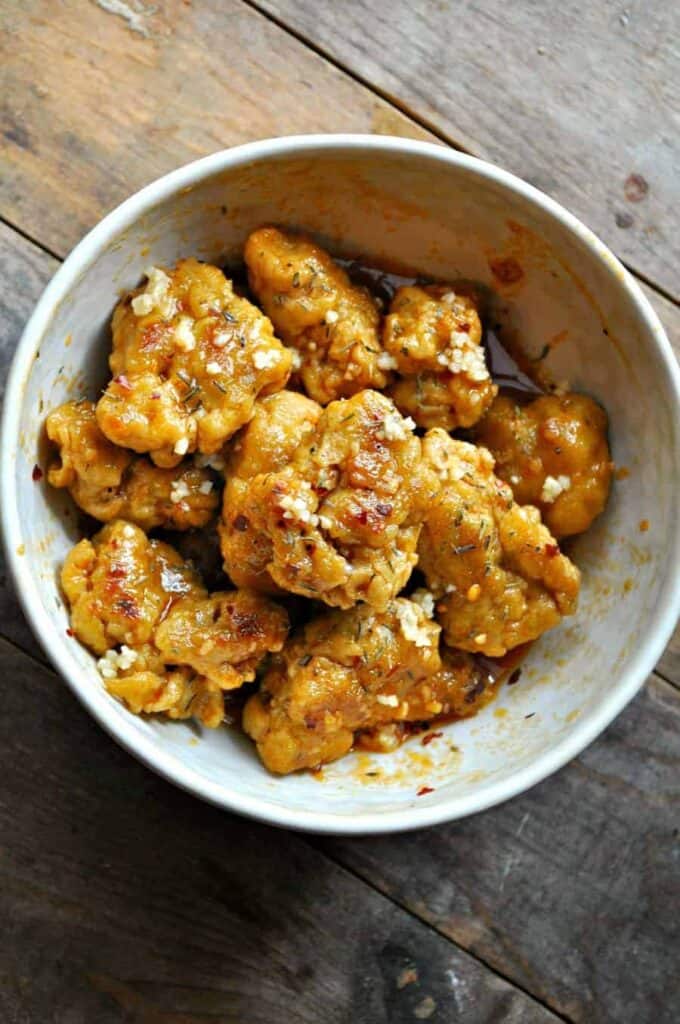
Get the recipe: Vegan Garlic Ranch Seitan Wings By Rabbits & Wolves
Vegan BBQ Wings With Seitan

Get the recipe: The BEST Vegan Seitan Wings With Barbecue Sauce By World of Vegan
Vegan Asian Chicken Wings With Seitan

Get the recipe: Vegan Asian Chicken Wings By: This Savory Vegan
Vegan Schnitzel With Seitan

Get the recipe: Best Vegan Schnitzel By The Simple Sprinkle
Vegan Nashville Chicken Sandwich With Seitan

Get the recipe: Vegan hot maple ranch Nashville chicken sandwich By Its Livb
Vegan Chicken Parmesan With Seitan

Get the recipe: The Best Vegan Chicken Parmesan By: tyberrymuch
Vegan Chicken Skewers With Seitan

Get the recipe: Peppery seitan “chicken” skewers with fresh corn & ranch dip By: Its Livb
Vegan Spring Chicken Parmesan With Seitan

Get the recipe: Vegan Spring “Chicken” Parmesan By Rabbit and Wolves
Vegan Air Fried Chicken With Seitan

Get the recipe: Vegan Air Fried Chick’n By Six Vegan Sister
Vegan Chicken Strips With Seitan
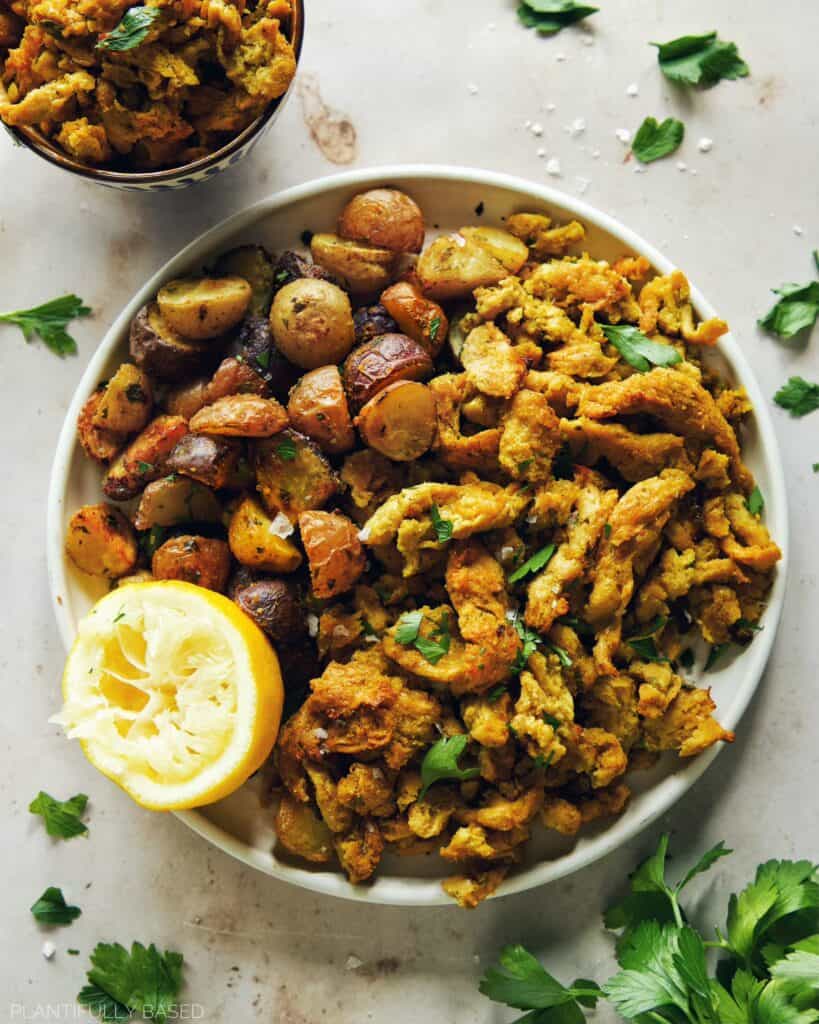
Get the recipe: Vegan “Chicken” Strips By: Plantiful
Vegan Butter Chicken Curry With Seitan

Get the recipe: Butter Chicken Curry By Sanjana Feasts
Vegan McChicken Sandwich With Seitan

Get the recipe: Vegan McChicken Sandwich (Copycat Recipe!) By It’s Livb
Vegan Baked Chicken Cutlets With Seitan

Get the recipe: Crispy Baked Seitan Chick’n Cutlets By Plantiful
Vegan KFC Chicken Bowl With Seitan

Get the recipe: Vegan KFC bowl recipe By: Its Livb
Vegan Chicken Tenders With Seitan

Get the recipe: Vegan Seitan Tenders By It Doesnt Taste Like Chicken
Vegan Breaded Chicken Tenders With Seitan

Get the recipe: Seitan Chick’n Tenders w/ Dipping Sauce By: Six Vegan Sister
Spicy Baked Vegan Popcorn Chicken With Seitan
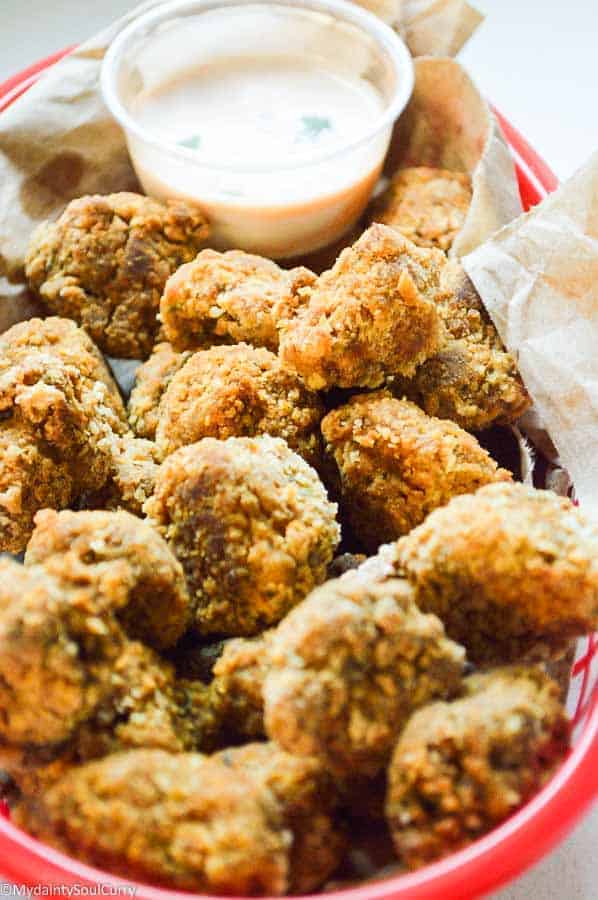
Get the recipe: Spicy Baked Vegan Popcorn Seitan Recipe By: My Dainty Soul Curry
Vegan Seitan Chicken Wings

Get the recipe: Vegan Seitan Wings By: Nora Cooks
Vegan Chicken On Toast With Seitan

Get the recipe: Vegan cheesy pesto toast with seitan chicken By: itslivb
Vegan Teriyaki Chicken With Seitan
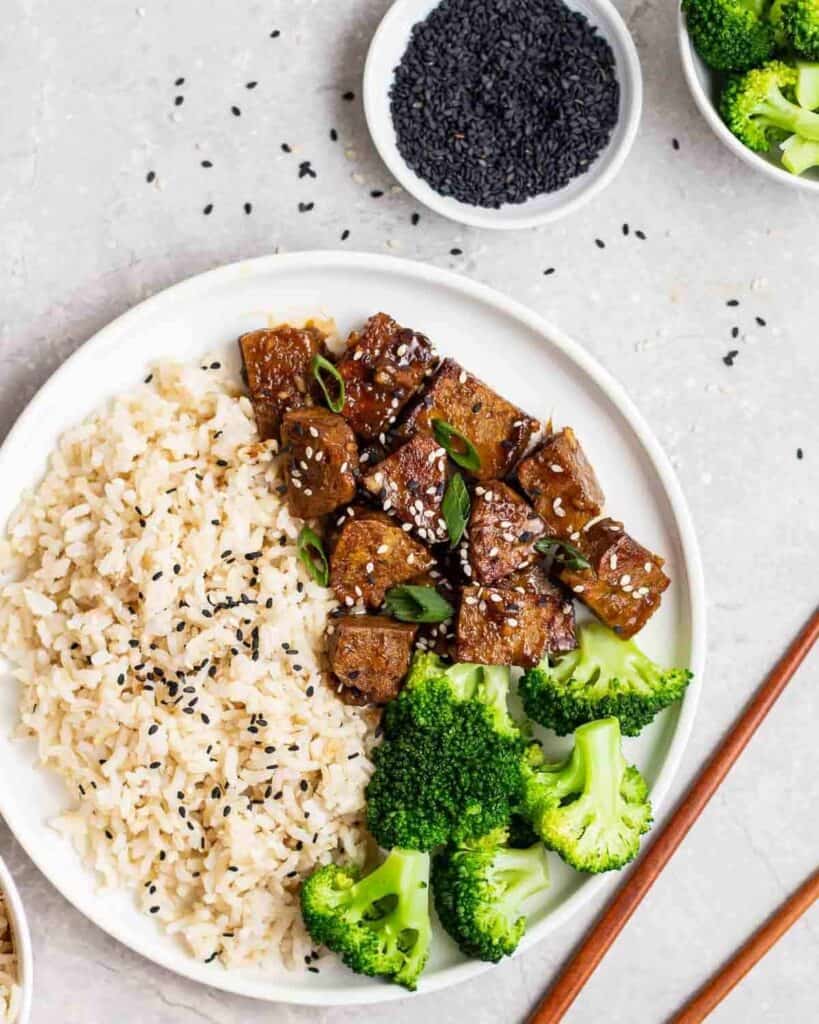
Get the recipe: Vegan Teriyaki Seitan ‘Chicken’ By: My Plantiful Cooking
Fried Vegan Chicken Burger With Seitan

Get the recipe: Seitan Fried ‘Chicken’ Burger By: Thee Burger Dude
Vegan Gyros With Seitan

Get the recipe: Seitan Gyros By The Hidden Veggies
Vegan Stuffed Chicken With Seitan

Get the recipe: Cheesy basil-stuffed chick’n in creamy tomato sauce By: itslivb
Vegan Chicken Drumsticks With Seitan

Get the recipe: Vegan Chicken Drumsticks By: Okonomi Kitchen
Vegan Cordon Bleu With Seitan

Get the recipe: Best Vegan Cordon Bleu By: The Simple Sprinkle
Vegan Flour and Water Chicken With Seitan

Get the recipe: Flour and Water Chicken (Seitan – Washed Flour Method) By: The Hidden Veggies
Vegan Chicken Strips With Seitan
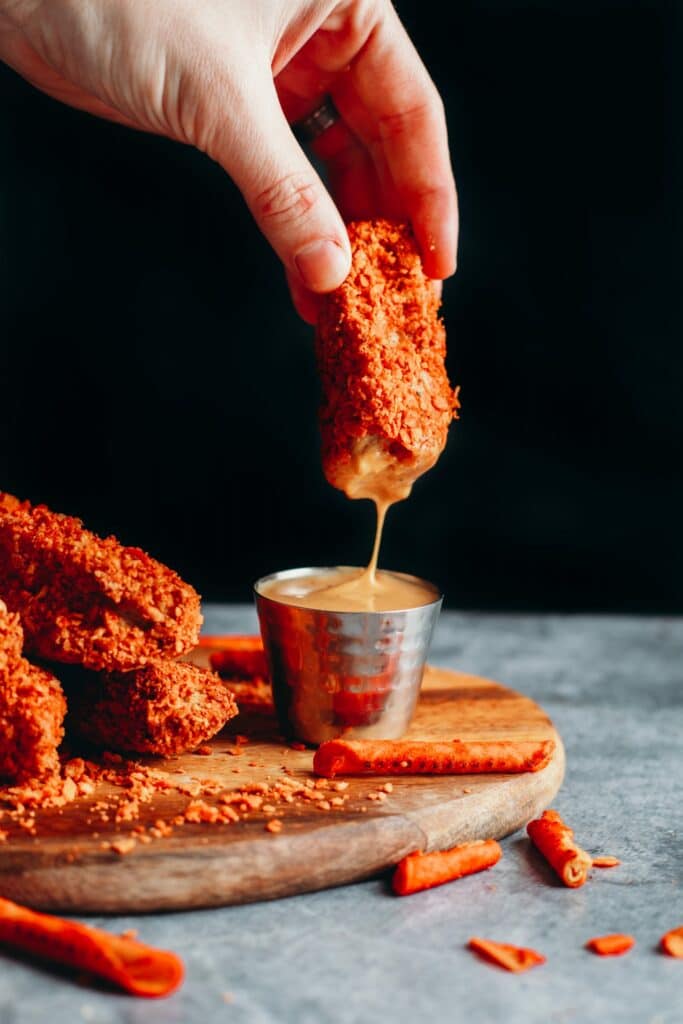
Get the recipe: Vegan chick-fil-a sauce and fuego chicken strips By: itslivb
Beef And Pork Substitutes For Meat Recipes With Seitan
BEEF & PORK SEITAN RECIPES
Vegan Burger With Seitan

Get the recipe: Vegan Seitan Burger By: It Doesnt Taste Like Chicken
Vegan Pot Roast With Seitan
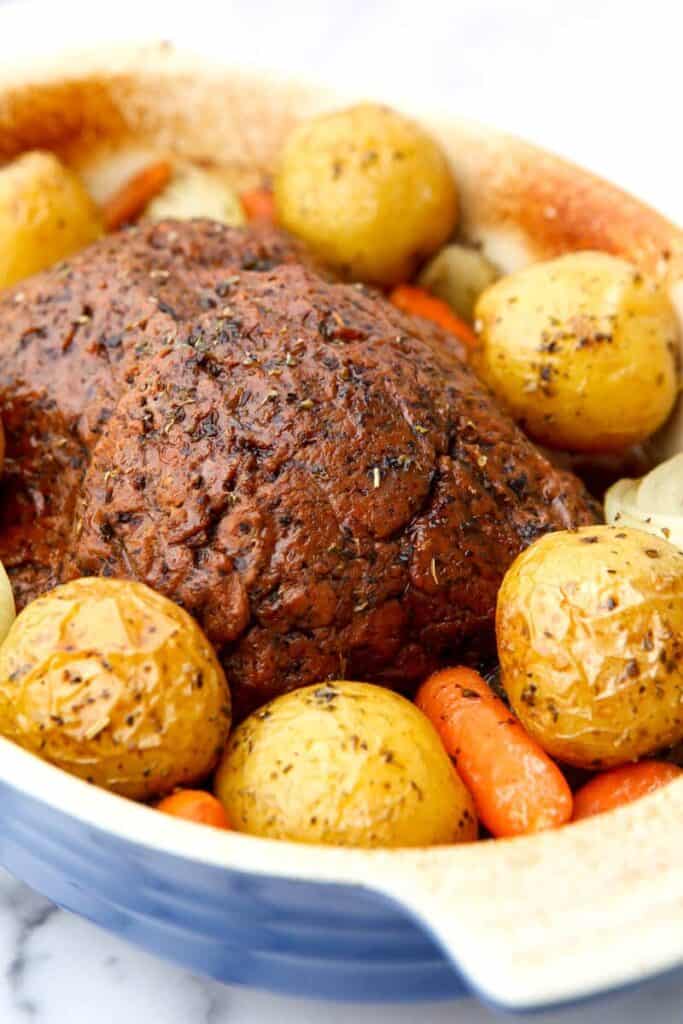
Get the recipe: Seitan pot roast vegan By: The Hidden Veggies
Vegan Bacon With Seitan
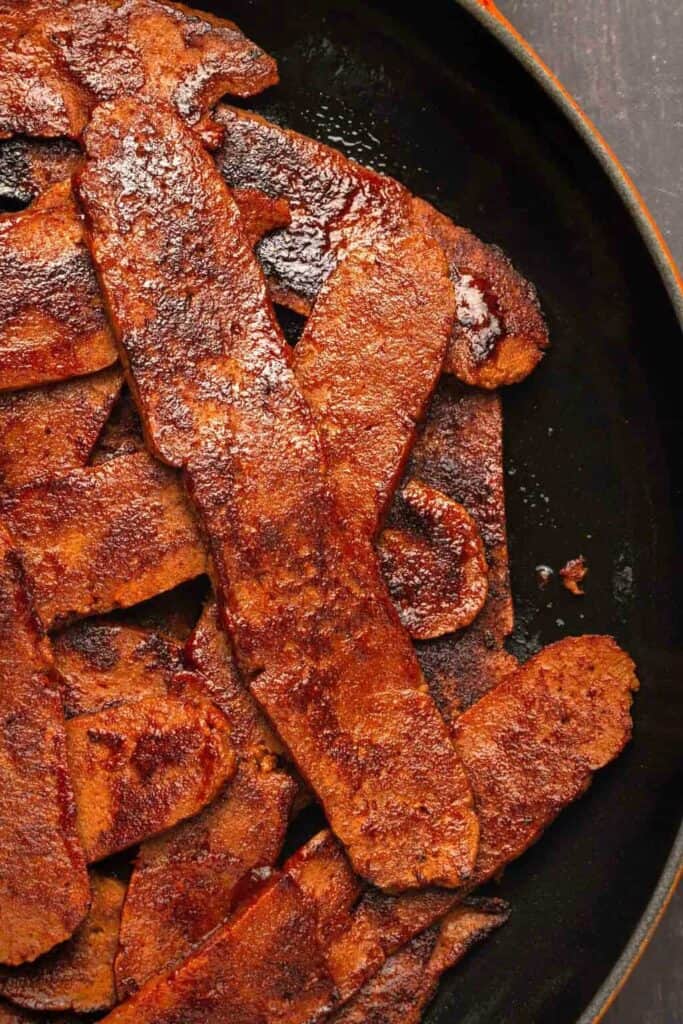
Get the recipe: Vegan Bacon By: Loving it Vegan
Vegan Pork Chops With Seitan
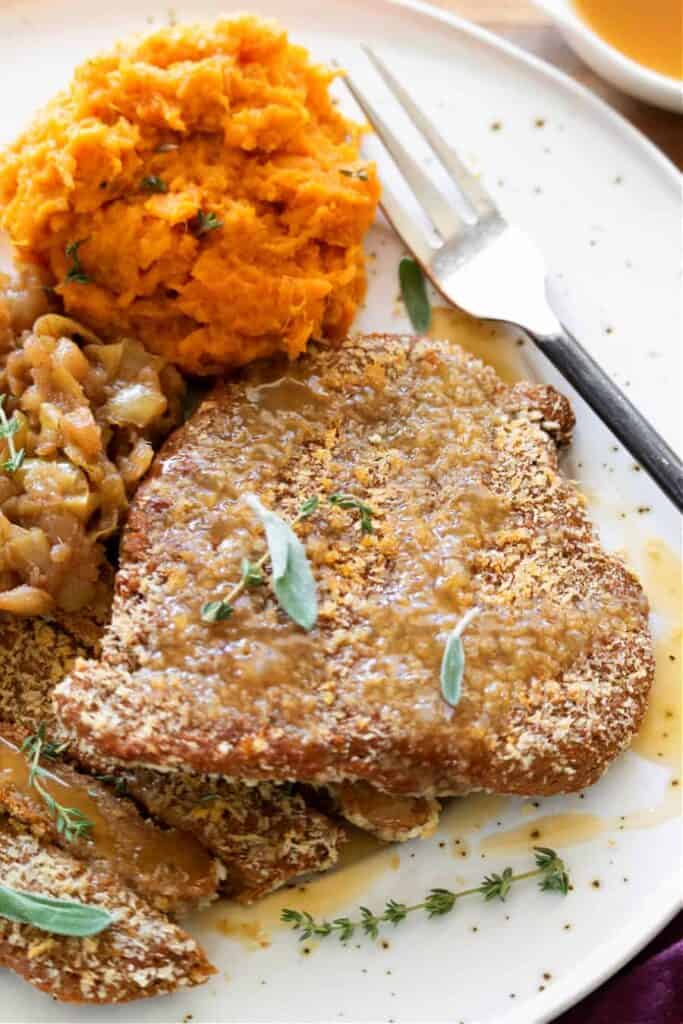
Get the recipe: Vegan “Pork Chops” and Applesauce By: Rabbit And Wolves
Vegan Carne Asada With Seitan
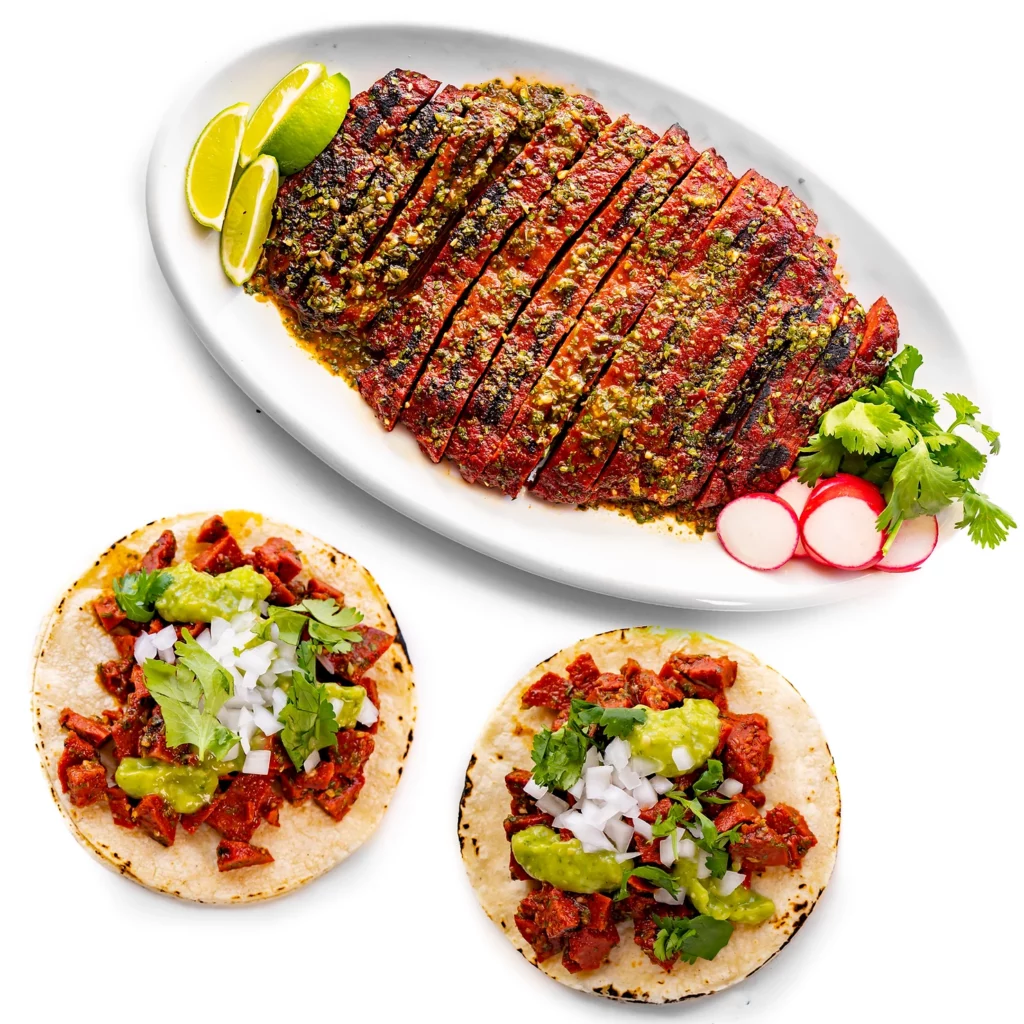
Get the recipe: Vegan Carne Asada (Seitan) By: Thee Burger Dude
Vegan Kebabs With Seitan

Get the recipe: Smoky Seitan Kebabs With Peanut Sauce By: World of Vegan
Vegan Philly Cheesesteak With Seitan

Get the recipe: Seitan Philly Cheesesteaks By Six Vegan Sisters
Vegan Sticky BBQ Ribs With Jackfruit & Seitan
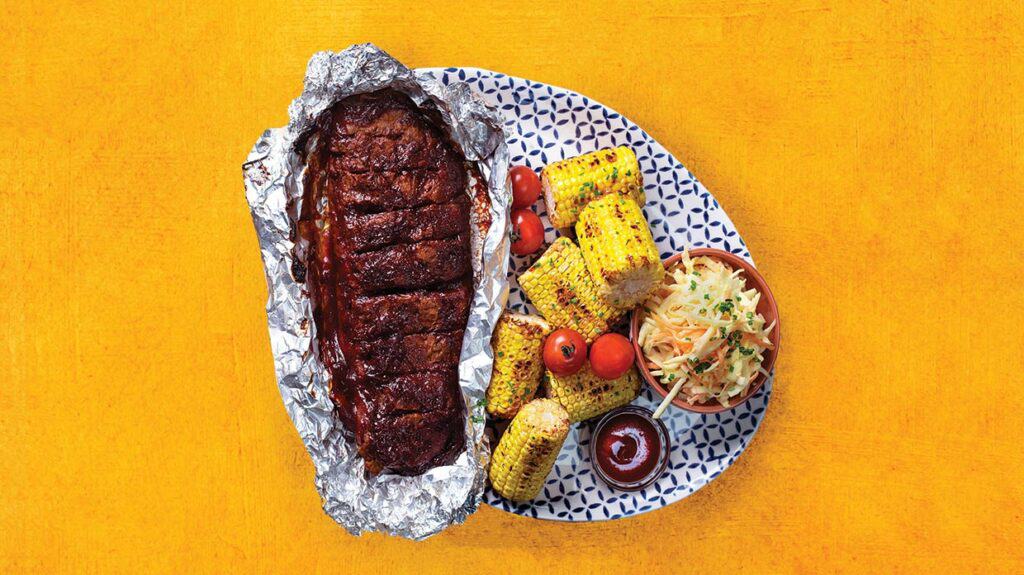
Get the recipe: Vegan Sticky BBQ Jackfruit & Seitan ‘Ribs’ By: Vegan Food And Living
Vegan Chinese BBQ Pork With Seitan

Get the recipe: Vegan Char Siu (Chinese BBQ Pork) By: Okonomi Kitchen
Vegan McRib Sandwich With Jackfruit & Seitan

Get the recipe: Jackfruit Seitan McRib By: Thee Burger Dude
Vegan Sticky Asian Ribs With Seitan
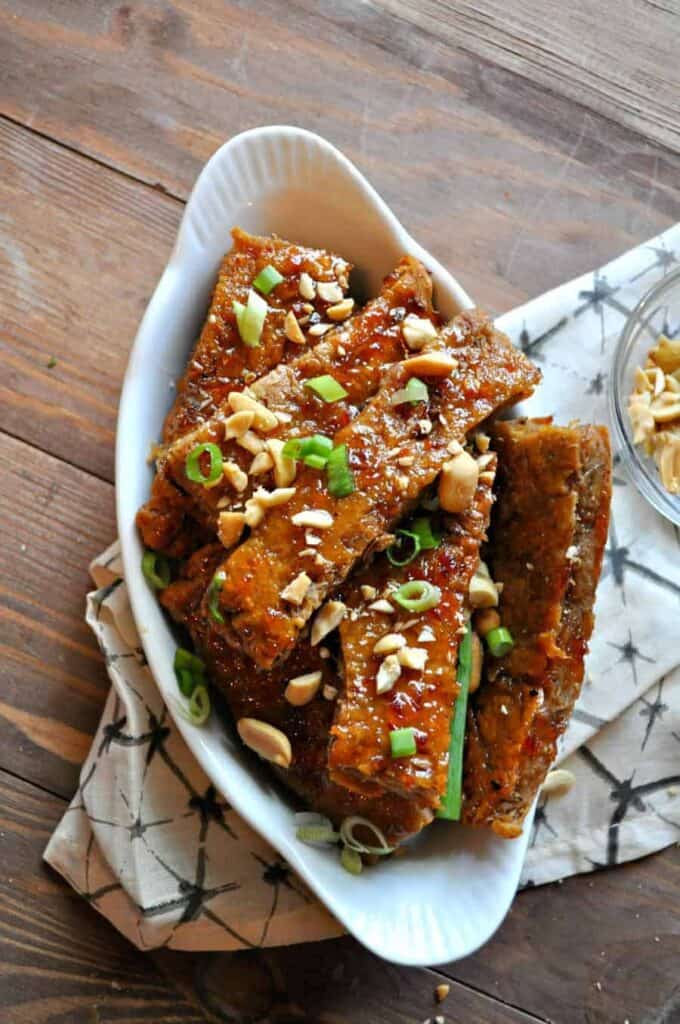
Get the recipe: Vegan Sticky Asian Seitan Ribs By: Rabbit & Wolves
Vegan Sticky BBQ Ribs With Seitan

Get the recipe: Sticky BBQ Vegan Ribs By: Ty Berry Much
Vegan Kebabs With Seitan
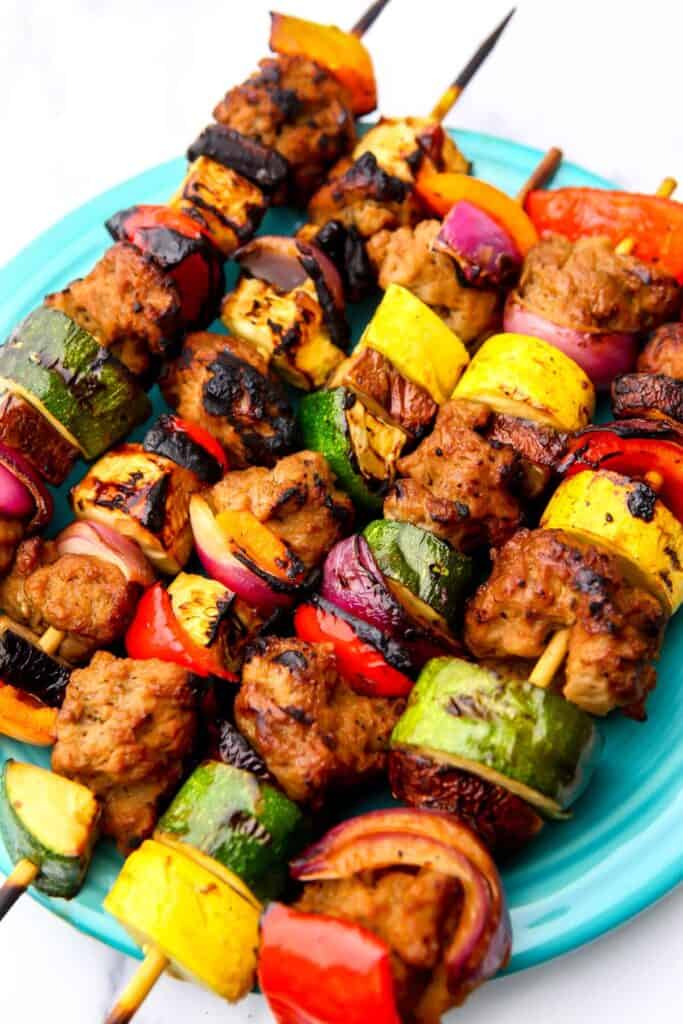
Get the recipe: Seitan Kebabs By: The Hidden Veggies
Vegan Steak With Seitan
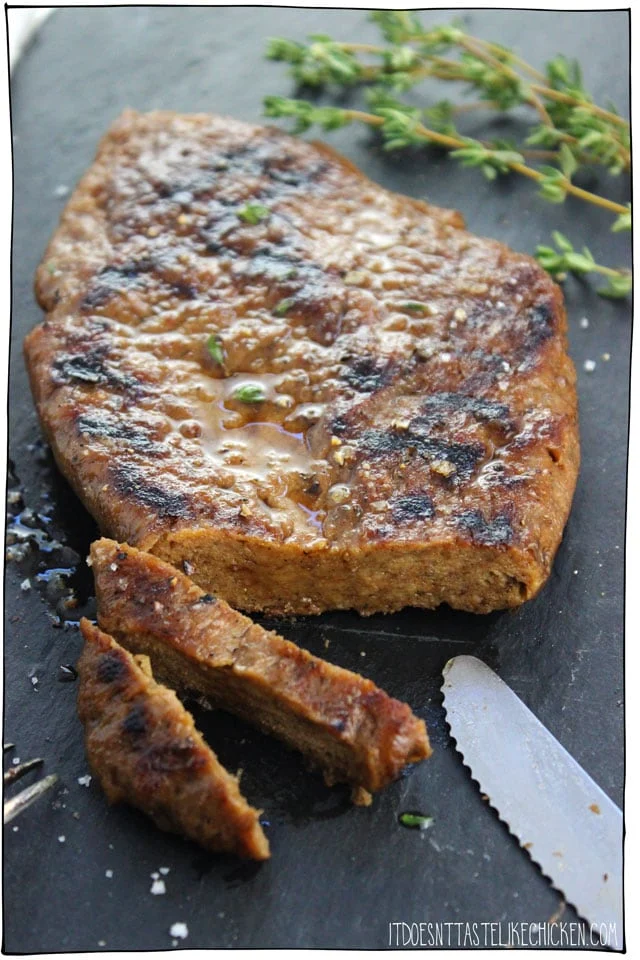
Get the recipe: Vegan Seitan Steaks By: Sam Turnbull
Vegan Meatballs With Seitan
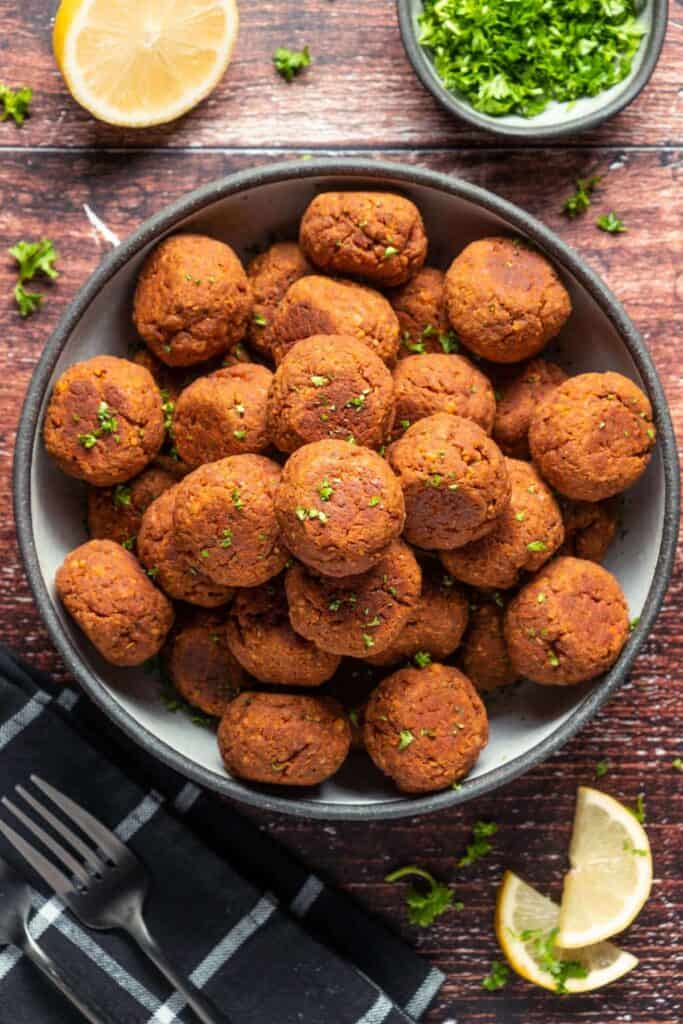
Get the recipe: Vegan Meatballs By: Loving it Vegan
Vegan Chinese Ribs With Seitan
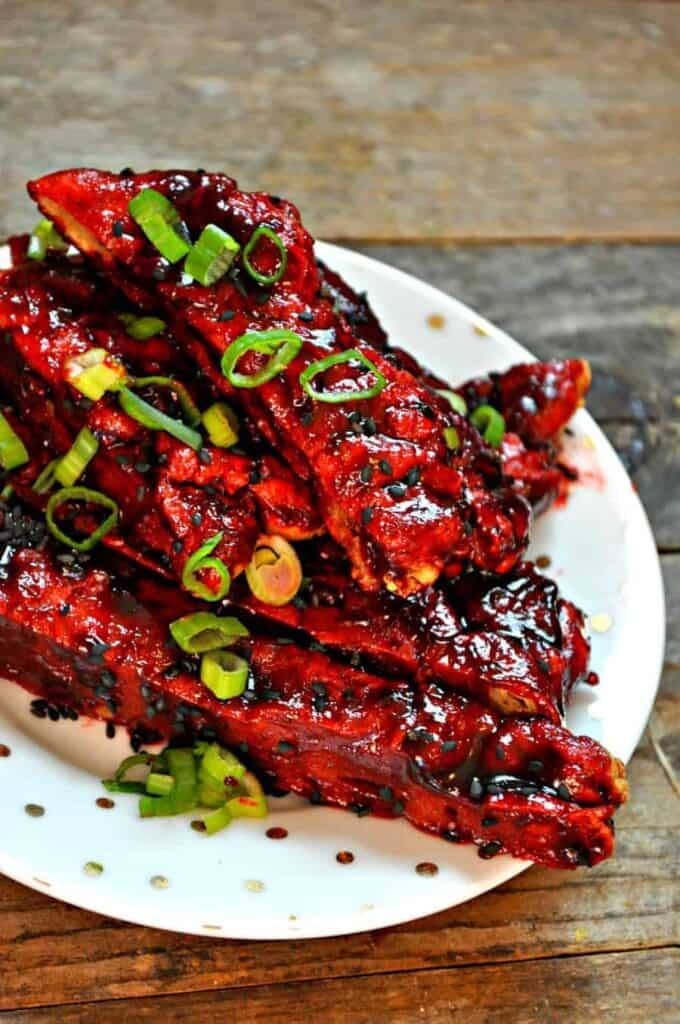
Get the recipe: Vegan Chinese Style Ribs By: Rabbit and Wolves
Vegan Mongolian Beef With Seitan
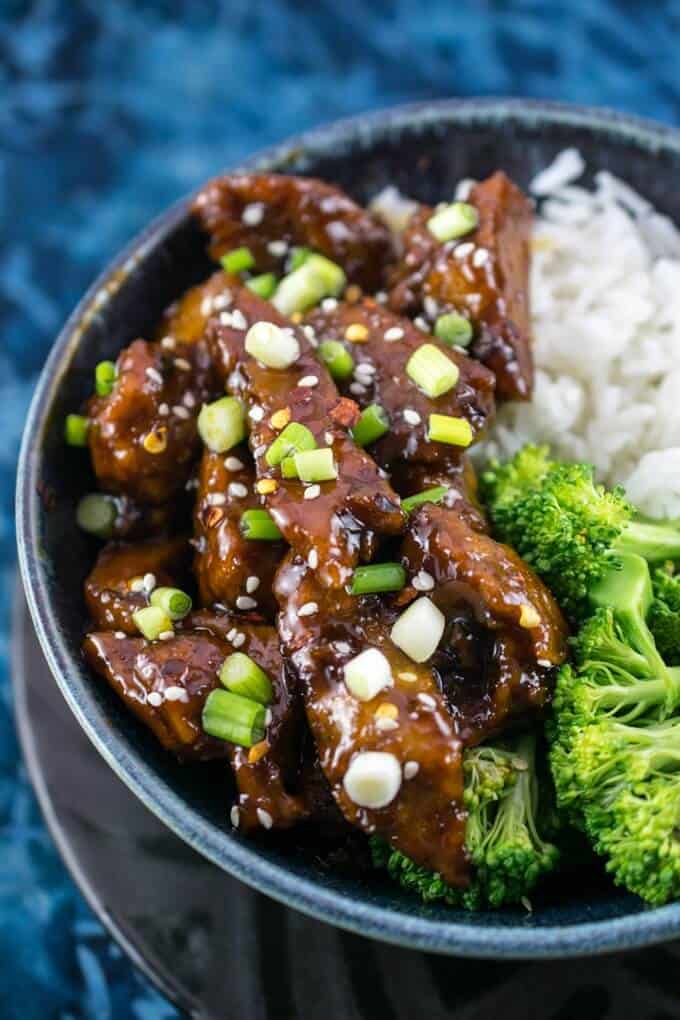
Get the recipe: Mongolian Seitan By: Yup It’s Vegan
Vegan Corned Beef With Seitan

Get the recipe: Seitan Corned Beef By The Hidden Veggies
Vegan Brisket With Seitan

Get the recipe: Vegan Seitan Brisket By: Gaz Oakley
Vegan Beef Tacos With Seitan

Get the recipe: Vegan Two-Layer Mojo Seitan Tacos By: Rabbit and Wolves
Vegan Roast Beef With Seitan

Get the recipe: Vegan roast beef recipe By: The Hidden Veggies
Sausage And Deli Substitutes For Meat Recipes With Seitan
SAUSAGE & DELI MEAT SEITAN RECIPES
Vegan Italian Sausages With Seitan

Get the recipe: Vegan Italian Seitan Sausages By: It Doesnt Taste Like Chicken.
Vegan Breakfast Sausage Links With Seitan
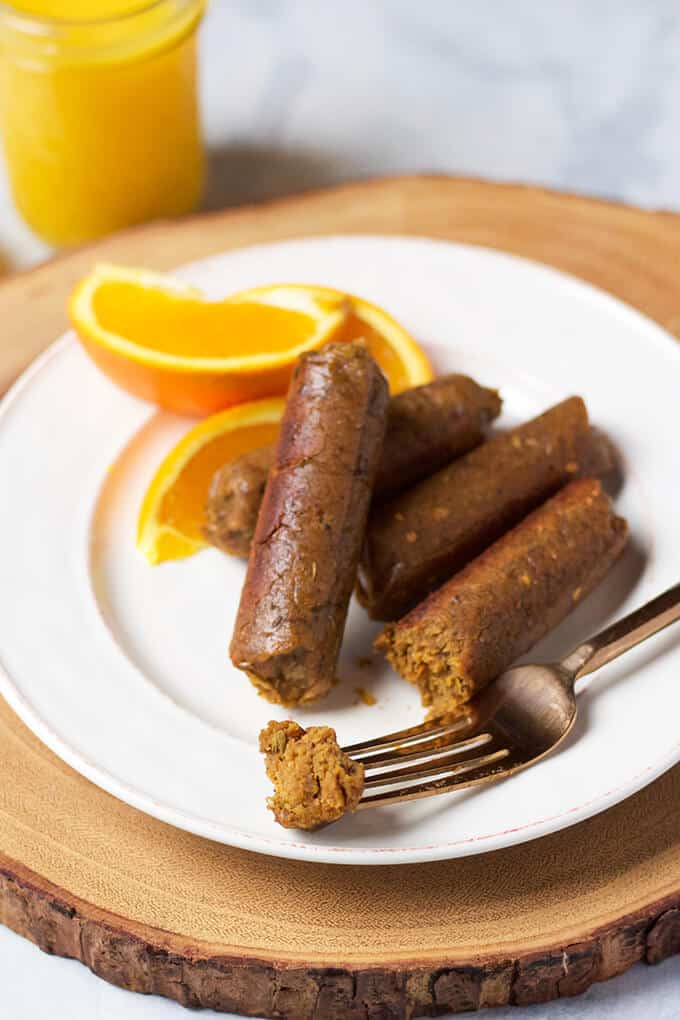
Get the recipe: Vegan Maple Breakfast Sausage Links By: Karissa’s Vegan Kitchen
Homemade Vegan Sausages With Seitan

Get the recipe: Homemade Vegan Sausages By Elephantastic Vegan
Vegan Pepperoni With Seitan
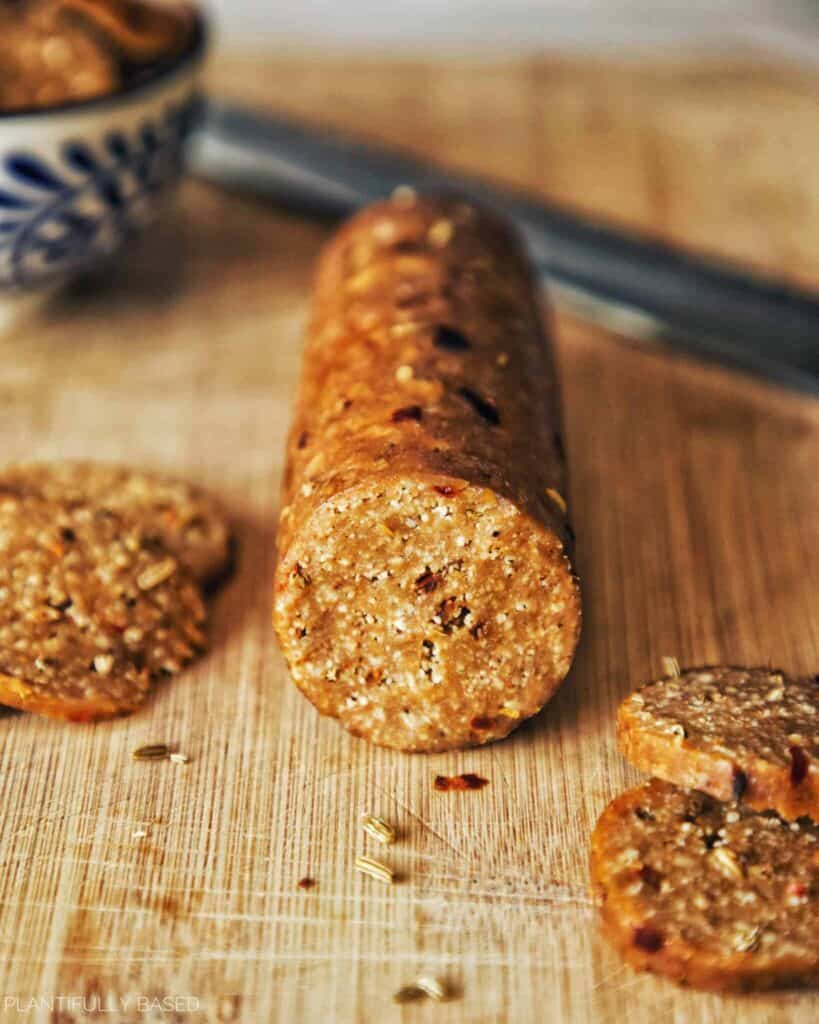
Get the recipe: Homemade Vegan Pepperoni With Seitan By: Plantifully Based
Vegan Salami With Seitan

Get the recipe: Vegan Salami By: Loving It Vegan
Vegan Deli Slices With Seitan
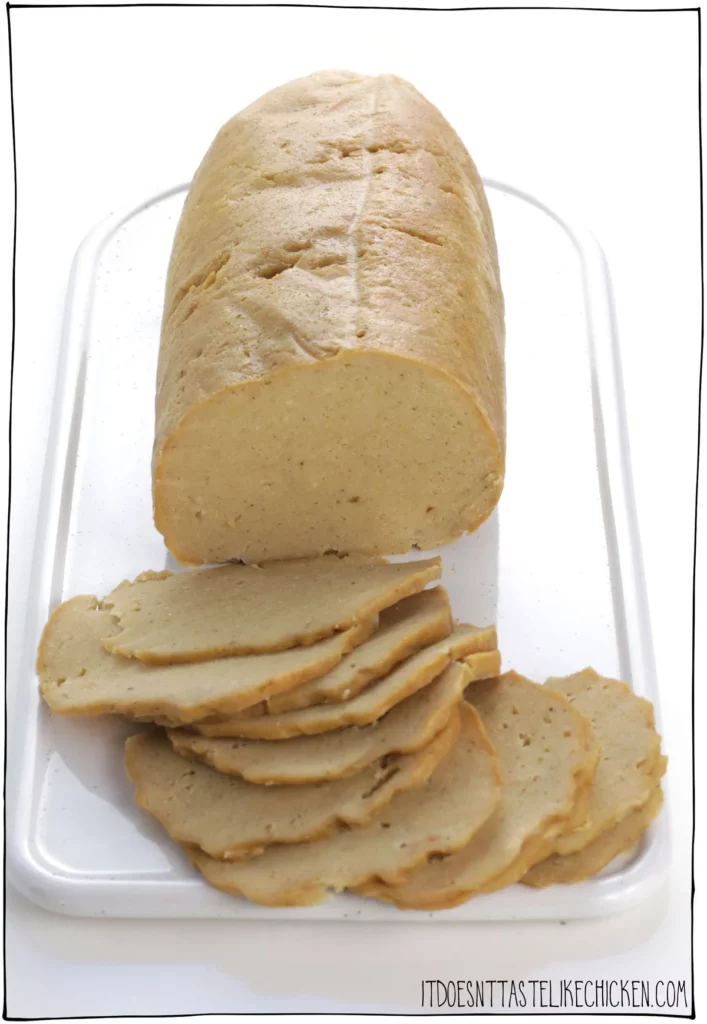
Get the recipe: Homemade Vegan Deli Slices (Smoked Seitan Turkey) By: It Doesnt Taste Like Chicken
Other Substitutes For Meat Recipes With Seitan Recipes
BASIC & OTHER SEITAN RECIPES
Basic Easy Seitan Recipe
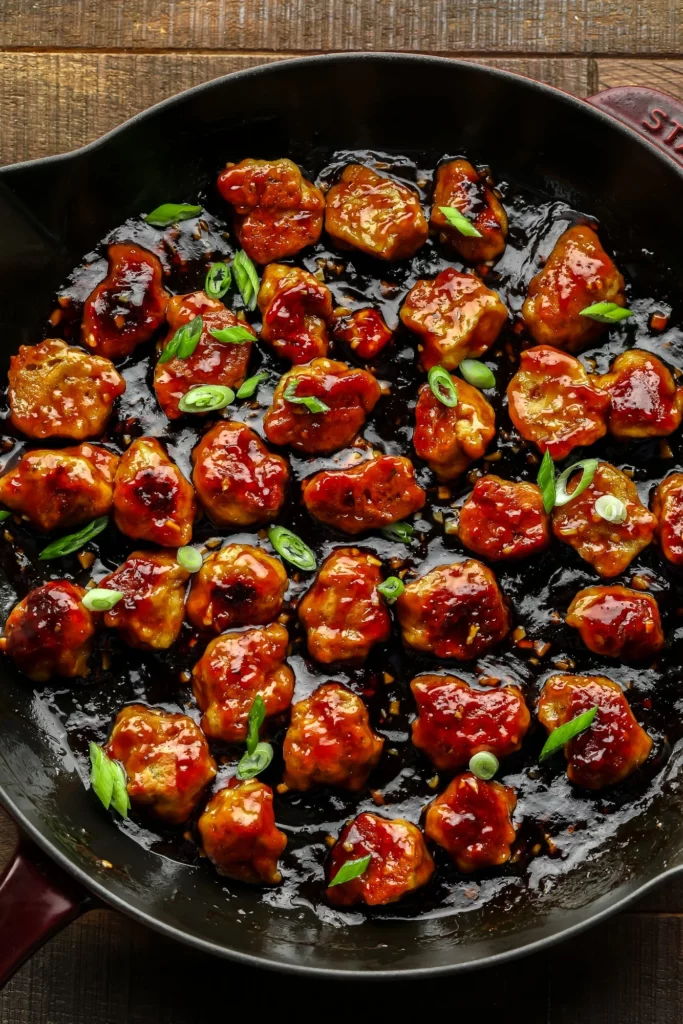
Get the recipe: Easy Seitan Recipe By: Nora Cooks
Seitan Marinades
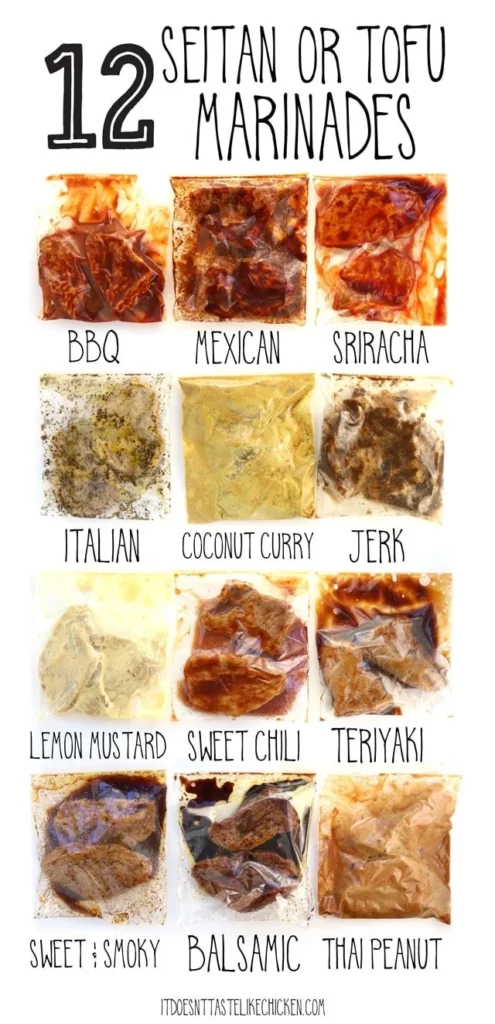
Get the recipe: Seitan Marinades By: It Doesn’t Taste Like Chicken
Vegan Shrimp Stir Fry With Seitan

Get the recipe: Vegan Chili Shrimp Stir Fry (Ebi Chili) By: Okonomi Kitchen
Holiday Substitutes For Meat Recipes With Seitan
HOLIDAY SEITAN RECIPES
Vegan Goose Recipe With Seitan
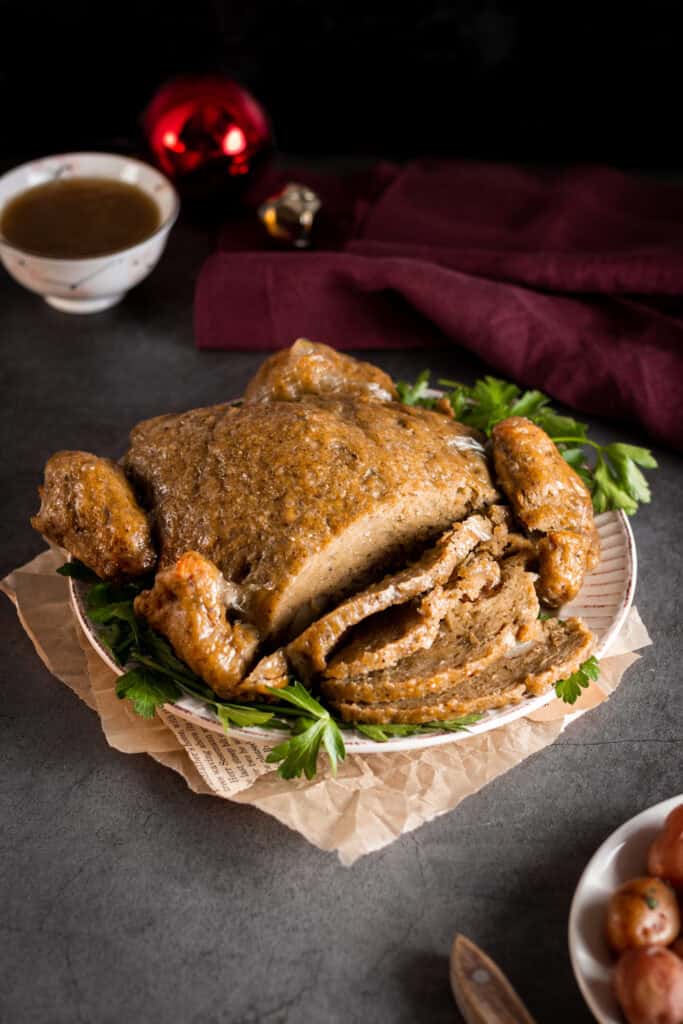
Get the recipe: Vegan Christmas Goose — Traditional German Recipe By: The Simple Sprinkle
Vegan Turkey Roast With Seitan
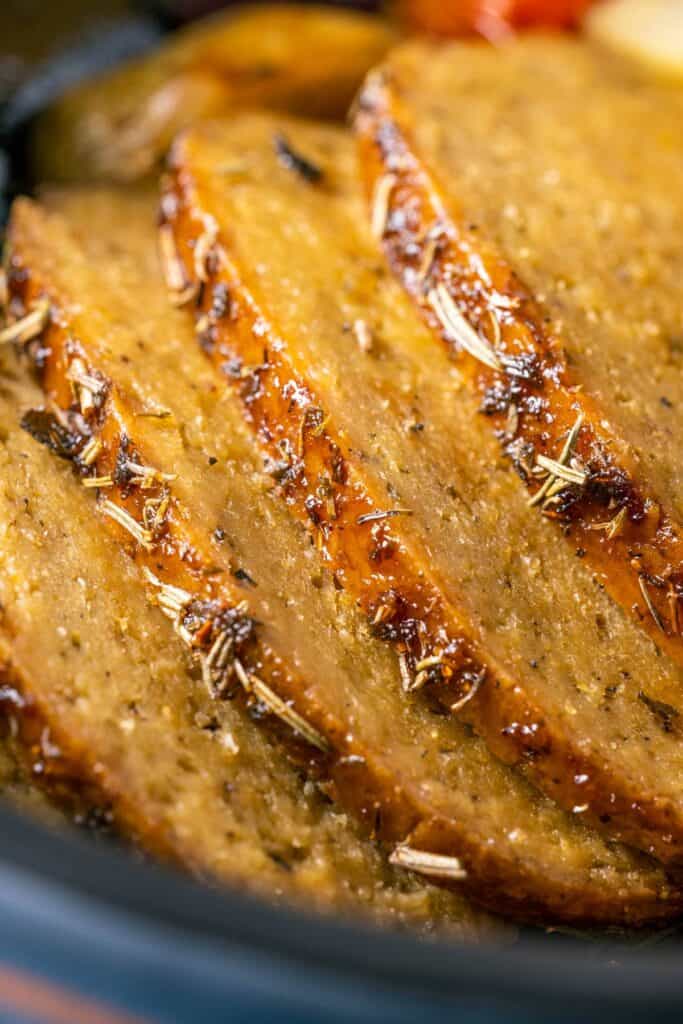
Get the recipe: Vegan Turkey Roast By: Loving It Vegan
Vegan Ham With Seitan
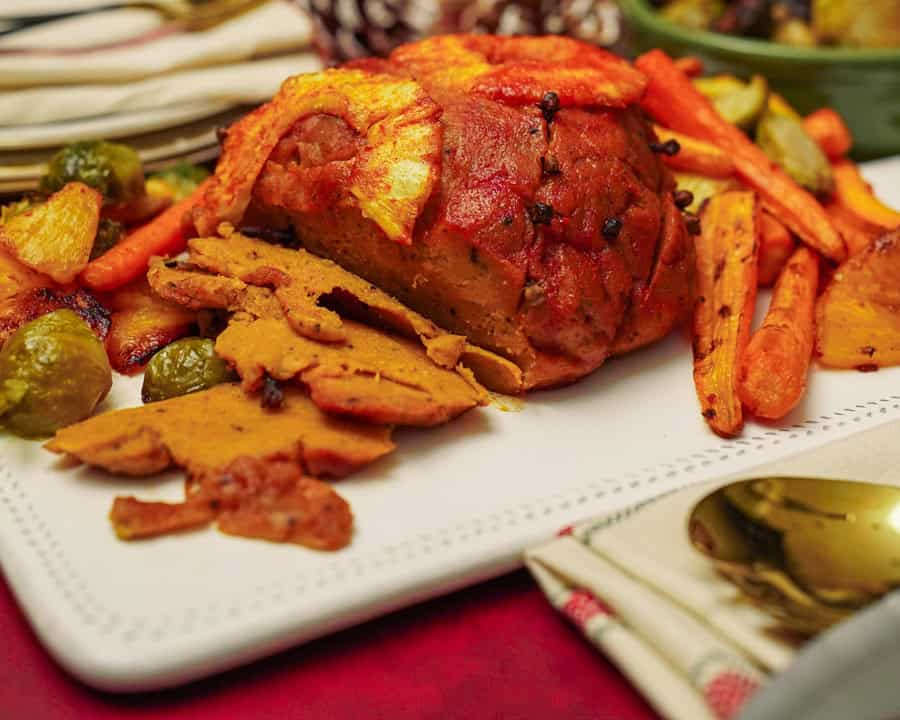
Get the recipe: Vegan Glazed Ham Roast Recipe By: The Edgy Veg
Vegan Roast Turkey With Seitan
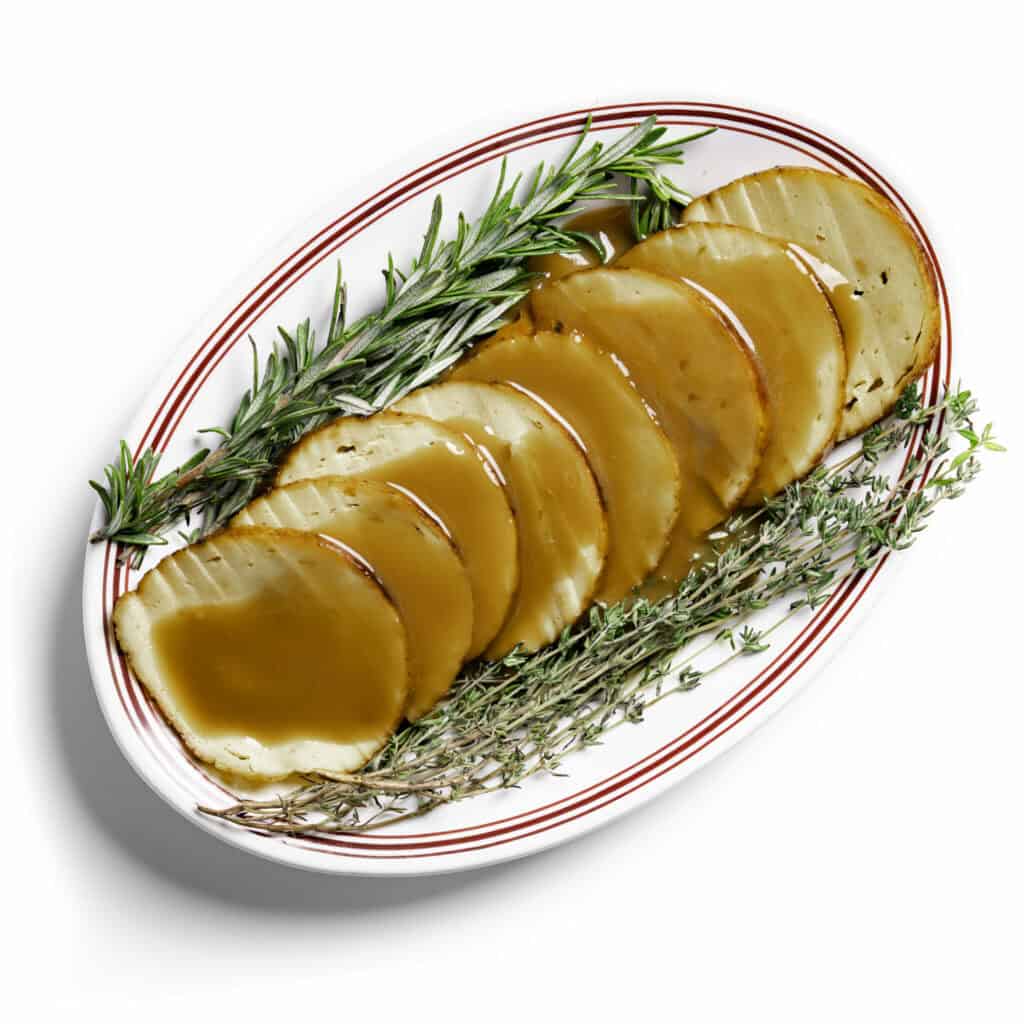
Get the recipe: Vegan Roast Turkey (Seitan) By: Thee Burger Dude
FAQs About Seitan Recipes
No, seitan contains gluten and should not be consumed by individuals with gluten sensitivities or celiac disease.
You can find seitan at most health food stores in the refrigerated section. It’s available in various flavors and textures.
Seitan can be used in a wide range of recipes. Its versatility allows you to adapt it to various cuisines and dishes.
Yes, both homemade and store-bought seitan can be frozen for extended storage.
While seitan is protein-rich, it may lack certain essential amino acids, so it’s advisable to combine it with other protein sources for a complete profile.
Conclusion: Seitan Recipes:
In conclusion, Seitan emerges as a compelling plant-based meat alternative, celebrated for its nutritional value, versatility in cooking, and cultural adaptability. As individuals explore sustainable and health-conscious dietary choices, Seitan stands out as a viable and delicious option. Try out this vegan meat substitute and see why it is becoming one of the most popular high protein content options.
Sources: Seitan Recipes
- Harvard T.H. Chan School of Public Health
- Mayo Clinic
- WebMD




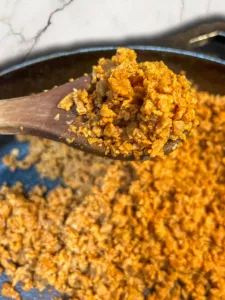
Nice information thank you. I’m going to try cooking some this weekend.
You’re welcome! I’m glad you found the information helpful. Have a fantastic time cooking this weekend! If you need any assistance or have questions while preparing the dish, feel free to reach out. Happy cooking!